The concept of the extended enterprise is based on the importance of cooperation between all parties involved in a value chain (e.g. co-design of products, assembly of complex systems, supply chain, suppliers/distributors, etc.).
Other concepts also lie behind this term that first emerged in the 1990s, including the supplier ecosystem, co-creation, networked systems, etc.
However, in practical terms, it entails networking and integrating all those concerned in a given chain, be they customers, suppliers or partners, making for a direct link to the issues surrounding information system openness. In fact, applications have shifted from being a means of accessing content to being the main channel of interaction between a business and its customers, employees, suppliers and partners.
However, while businesses fully appreciate the need for openness, determining a strategy for effective integration with their ecosystems is far from obvious.It nevertheless underpins the extended enterprise. Spanning ideas of stability, real time, scalability, standardisation, security, governance, monitoring…. this strategy of openness is directly linked to business expansion and business model development.

Download our White Paper on API Management
ESB vs APIM – two aspects of the same integration strategy
The strategy of integrating with the ecosystem is based on two dovetailing components:
- IS service orchestration, which is the role played by the ESB (Enterprise Service Bus) ;
- Governance over interchanges with the outside world, which is the role of API management.
While similarities can be seen in the software solutions built for ESB and API management, that does not mean that each can play the other’s role, but rather than they are two sides of the same coin.
From the viewpoint of solutions to implement, they are definitely two different, if complementary, steps, each with a specific objective:
ESB
An ESB or Enterprise Service Bus can be defined as a toolkit ensuring the security of data interchanges between sources and targets in an information system. The central component of an ESB can be described as a channel used to convey data between applications called an “application bus”).
APIM
The purpose of API Management is to manage and standardise API (Application Programming Interface) exposure, i.e. the publication, promotion and supervision of interchanges between a supplier service and a client service. API Management provides portals that can be used to monitor the use made of exposed APIs.
The key questions for structuring an ESB APIM integration strategy
Once the two software solutions have been chosen and their respective roles determined, the issue becomes deciding upon the strategy to implement to integrate with the wider ecosystem.
There is no single perfect integration strategy that will suit every business. It differs in fact depending on the importance placed on sharing data in the business model and likely developments in data interchange and services with the ecosystem concerned. Business requirements must take precedence over technical constraints.
The answers to the following questions can help set an initial framework for the ESB APIM integration strategy:
- What do you want to expose, to whom and with what objectives?
- What business requirements emerge from your business model as regards inbound and outbound data traffic? This entails examining data flows and the business model to determine which services are needed and the target consumption.
- What degree of security and control is required?
- How quickly should the integration be extended? What is the expected scalability of each service?
- What level of granularity is sought when opening up services? Are there any differences in access at start-up (e.g. for the top 10 premium customers versus the others)?
- How mature is your ecosystem? Will suppliers have to make an effort to standardise how they provide their data? The development of your integration strategy and its scalability are also in fact dependent on your ecosystem partners’ ability to get involved.
- Do processes need to be defined with partners beforehand? In some cases, such as data exposure (for example, providing product catalogue data), it is not necessary; in other, more complex situations, it is crucial.
- What type of data sharing is involved? Is the approach akin to a partnership? Are services paid, or free of charge?

Download our expert view on the complementary use of ESB and APIM solutions
Conclusion: your business objectives should guide your ESB APIM integration strategy
While, from a business viewpoint, these integration possibilities represent a fundamental transformation opening many doors, from an IT viewpoint, it is mainly a matter of extending a service-oriented strategy from the internal IS to the whole business ecosystem. The principle behind the approach is therefore fairly clear: to avoid increasing numbers of point-to-point connections between applications.
There are therefore admittedly some technical aspects (API versioning, security tokens, DMZ, etc.), but it is first and foremost your business transformation that should determine your integration and openness strategy.
If you would like to share feedback around data interchange governance with an ecosystem or extended enterprise, contact our experts.

Want to discuss API Management with an expert ?




